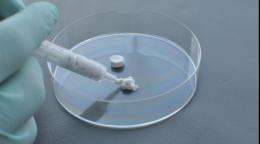Smart materials that get bone to heal

Bone tissue is very good at self-healing, but in many situations the natural healing process is not sufficient. In a dissertation at Uppsala University, Sonya Piskounova shows how functional materials that she and her colleagues have developed can form bone tissue in places in the body where there originally was no bone.
In complicated bone fractures it can be difficult to get all the small bone fragments to heal in the right way, and it requires complicated open surgery that in itself can result in complications, such as scarring and infection. In other situations it might be desirable to form bone in a place in the body where there is little or no bone, for example for inserting dental prostheses or treating patients following severe trauma or bone disease. This is why the research team that Sonya Piskounova is part of has developed smart materials that can get bone to form where you place it.
“We have developed multifunctional surface coverings that can get bone tissue to fasten better on titanium screws, for instance, which are used to fix dental prostheses,” says Sonya Piskounova.
The surfaces consist of, among other things, a layer of hydroxyapatite, a material that is similar to bone tissue and therefore makes it easier for bone to fasten to the surface than an untreated screw would. The dissertation also describes a simple method for loading screws with a special biomolecule, so-called BMP-2, which can issue orders to stem cells in the body to form new bone in this place. BMP-2 can be loaded into the screw directly in the operation room, thus enabling the surgeon to adapt the treatment to the patient.
BMP-2 is also used in another smart material, developed to form bone tissue in places in the body where little or no bone exists. As BMP-2 is a highly sensitive molecule that degrades after just a few minutes in the body, the researchers wanted to find a carrier that could be injected but is also sufficiently stable to survive for a few weeks while the BMP-2 does its work.
The solution turned out to be a gel based on hyaluronic acid, a substance that occurs naturally in all animals and people. The great advantage with this material is that it’s not necessary to perform open surgery, and because hyaluronic acid is recognized as endogenous, there is no risk of an immunological reaction. The gel has been developed and tested in close collaboration with physicians at Karolinska and Akademiska university hospitals in order for the scientists to gain direct insights into how it can be used in the best way.
“We’re not there quite yet, but we hope that it won’t be too long before these smart materials can be used on patients,” says Sonya Piskounova.
















